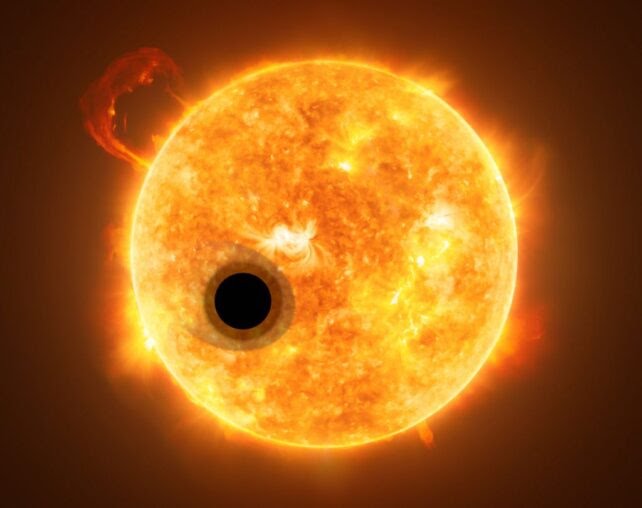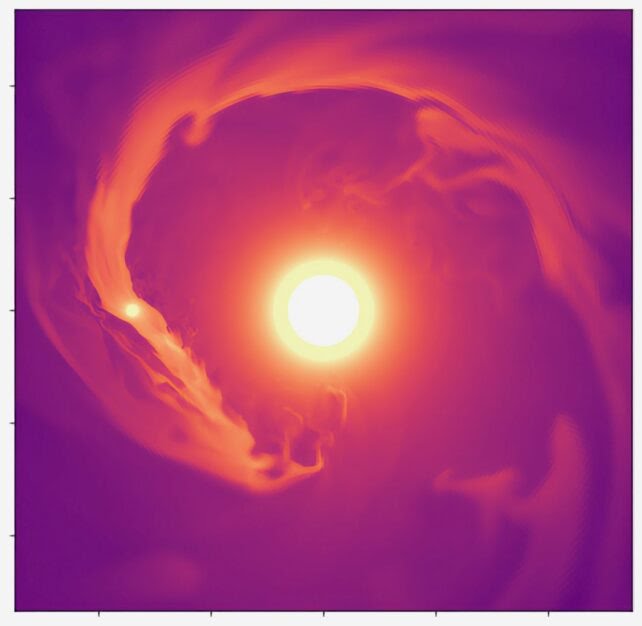A team of astronomers led by astrophysicist Zhoujian Zhang from the University of California, Santa Cruz, has made an intriguing discovery. They have observed an exoplanet called HAT-P-32b, located approximately 923 light-years away, with a highly leaky atmosphere.
This gas giant, about 1.8 times the radius of Jupiter, is spewing out enough gas to form two gigantic tails, spanning a distance greater than 53 times the exoplanet’s radius. The findings, recently published in a study, reveal the largest structures associated with an exoplanet ever observed.

The Puffy World and Its Fiery Orbit:
HAT-P-32b is a fascinating exoplanet with some unusual characteristics. It has a low density, only 10 percent of Jupiter’s, and it orbits its star at an incredibly close distance. Completing an orbit in just 2.15 days, HAT-P-32b is heated to a scorching temperature of around 1,836 Kelvin due to its proximity to a star slightly larger and hotter than the Sun. This intense heat causes the exoplanet to expand and become “puffy,” contributing to its leaky atmosphere.
Atmospheric Destruction and Transit Observations:
To study the atmosphere of HAT-P-32b, astronomers employ a technique called transit observations. During a transit, the exoplanet passes in front of its host star, causing slight fluctuations in the star’s light as it is partially blocked. This method provides valuable insights into the composition of the exoplanet’s atmosphere. However, previous observations only provided a glimpse of the atmospheric destruction caused by the star’s proximity.
The Leaky Atmosphere Revealed:
In the case of HAT-P-32b, the leaky atmosphere became apparent through careful analysis of transit data. Scientists noticed an excess of hydrogen alpha and helium, indicating the presence of these gases in the exoplanet’s atmosphere. However, the full extent of the leak remained unknown until recent observations.
Zhang and his team utilized the Hobby-Eberly Telescope at the McDonald Observatory in Texas to observe HAT-P-32b over several nights, covering its complete orbit rather than just the transit period. By analyzing the spectra obtained during these observations, they were able to identify variations in gases known to be leaking from the exoplanet’s atmosphere.

Gigantic Tails Discovered:
The analysis conducted by Zhang and his colleagues revealed the astounding scale of HAT-P-32b’s leaking atmosphere. The exoplanet is expanding so dramatically that it surpasses the point at which gas can remain gravitationally bound, resulting in the ejection of vast amounts of material into space. The team’s calculations suggest that approximately 33.8 trillion tons of gas are being released annually.
Implications and Future Studies:
The discovery of HAT-P-32b’s massive tails has significant implications for our understanding of exoplanetary atmospheres. With the rate of atmospheric loss observed, it is estimated that HAT-P-32b’s atmosphere will take around 40 billion years to completely evaporate. This exceptionally long timescale could aid astronomers in interpreting similar leaky gas exoplanets found in close orbits with their stars.
Astronomer Caroline Morley from the University of Texas at Austin notes that these findings on HAT-P-32b can provide insights into the interactions between planets and their stars. By studying hot Jupiters like HAT-P-32b in detail and extrapolating their findings, researchers can gain a better understanding of a broader range of exoplanets.
Conclusion:
The discovery of HAT-P-32b’s massive helium tails highlights the dynamic nature of exoplanetary atmospheres. This leaky gas giant, located in a scorching orbit, serves as a remarkable case study for astronomers seeking to understand the intricate relationship between planets and their host stars. As we continue to explore the vast expanse of the universe, it is likely that many more leaky exoplanets and their fascinating tales await our discovery.
FAQ’s About Gigantic Tails of Helium :
Q: What is HAT-P-32b?
A: HAT-P-32b is an exoplanet located approximately 923 light-years away, known for its leaky atmosphere and the formation of gigantic helium tails.
Q: How big are the tails of HAT-P-32b?
A: The tails of HAT-P-32b span a distance greater than 53 times the radius of the exoplanet, making them among the largest structures associated with an exoplanet ever observed.
Q: What causes the leaky atmosphere of HAT-P-32b?
A: The leaky atmosphere of HAT-P-32b is caused by its proximity to its star, which heats the planet to high temperatures, leading to the expansion and escape of gases from its atmosphere.
Q: How was the leaky atmosphere of HAT-P-32b discovered?
A: The leaky atmosphere of HAT-P-32b was revealed through transit observations, where the exoplanet passes in front of its host star, causing slight fluctuations in the star’s light. Analysis of the spectra obtained during these transits revealed the excess presence of hydrogen alpha and helium, indicating the leaky nature of the atmosphere.
Q: How long will it take for HAT-P-32b’s atmosphere to evaporate entirely?
A: It is estimated that it will take approximately 40 billion years for HAT-P-32b’s atmosphere to completely evaporate at the observed rate of gas loss.
Q: What can the study of HAT-P-32b help us understand?
A: By studying HAT-P-32b and similar hot Jupiters, scientists can gain a better understanding of how exoplanets and their stars interact, which can be applied to a wider range of planets and systems.
Q: What telescope was used to observe HAT-P-32b?
A: The observations of HAT-P-32b were conducted using the Hobby-Eberly Telescope at the McDonald Observatory in Texas.
